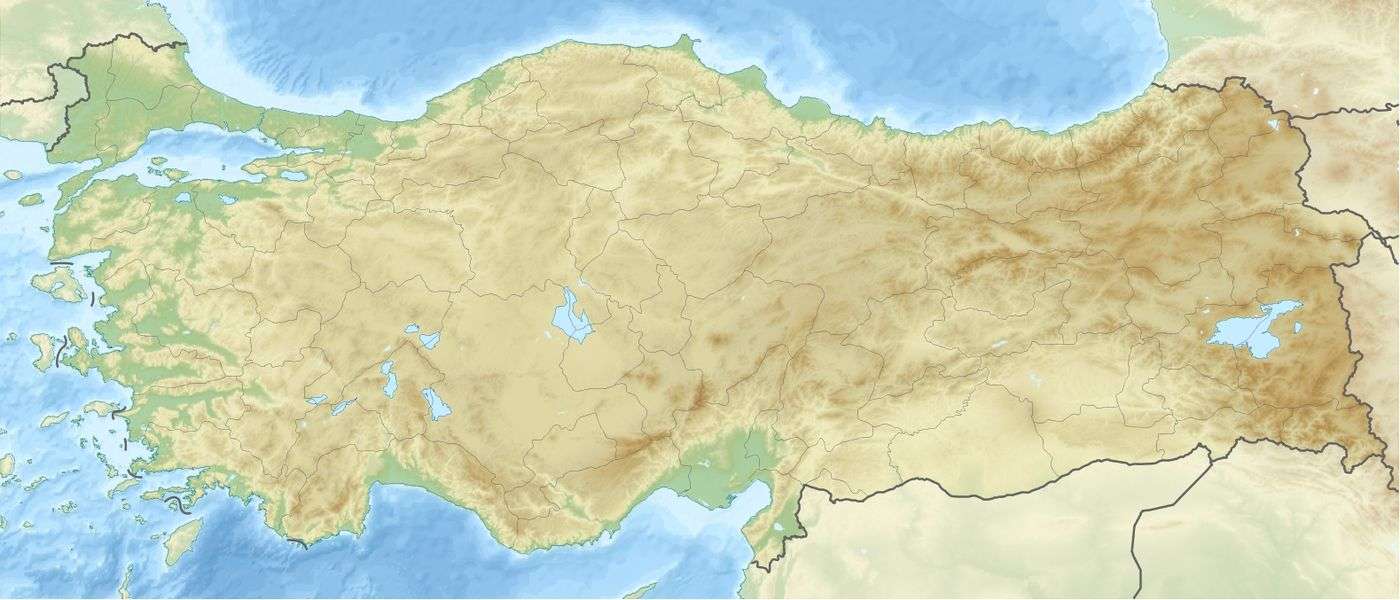Nysa Bridge
| Nysa Bridge | |
|---|---|
 Inside view of the "tunnel" downstream. The section in sunlight has collapsed, leaving two separate arches. The vault of the second-level arcade appears at the upper rim of the photo. | |
| Coordinates | 37°54′12″N 28°08′44″E / 37.903405°N 28.145514°ECoordinates: 37°54′12″N 28°08′44″E / 37.903405°N 28.145514°E |
| Carries | Substructure for theatre square |
| Crosses | Cakircak |
| Locale | Nysa (Sultanhisar), Caria, Turkey |
| Characteristics | |
| Design | Arch bridge |
| Material | Stone |
| Width | c. 100 m |
| Longest span | 5.7–7 m |
| Number of spans | 1 (bottom vault) |
| Clearance below | 5.9 m |
 Nysa Bridge Location in Turkey | |
The Nysa Bridge is a late imperial Roman bridge over the Cakircak stream in Nysa (modern Sultanhisar) in the ancient region of Caria, modern-day Turkey. The 100 m (328 ft) long substructure was the second largest of its kind in antiquity, after the Pergamon Bridge.[1]
Dating
The Greek geographer Strabo (63 BC–AD 21), who lived in Nysa, mentioned a secret water conduit in the town, but it remains unclear whether he meant the existing tunnel-like bridge.[2] An inscription at the northern wall of the tube, close to a bend after 25 m (82 ft), indicates a construction date in late imperial times.[3] It reads "Work of Praülos until this point".[4]
Construction
The Nysa Bridge served as a substructure for the area in front of the city theatre which lay close to the Cakircak stream.[5] It was built as a two-level structure: the bottom vault spanned the brook. On top of it a row of arches connected the two hills that formed the urban area. The ground arch spanned the stream on a length of some 100 m (328 ft), giving the bridge the appearance of a tube or a tunnel, although it was constructed entirely above ground. It consists of a single, 5.7 m (19 ft) wide vault whose uphill mouth widens to 7 m (23 ft). The overall height of its semi-circular arch is 5.9 m (19 ft), featuring a rise of 2.95 m (9 ft 8 in). The vault is made of rubble stone laid in mortar, resting on a substructure of ashlar stone blocks of varying size (0.3–0.9 x 1.0–1.4 m). Originally featuring a continuous vaulting, it is collapsed today between m 75 and 85, and again at the downhill exit. The remaining, isolated structure at the downstream side has often been incorrectly referred to as a bridge of its own.[6] The Nysa Bridge was the second largest bridge substruction of its kind in antiquity, only surpassed by the nearby Bridge at Pergamon.[1] By comparison, the width of a normal, free standing Roman bridge did not exceed 10 m (33 ft).[7]
In its further course, the Cakircak also ran through the city stadion, so that naumachia could be given. There are remains of two other ancient bridges both up- and downstream.[2]
Discharge capacity
The capacity limit of the Nysa Bridge in case of floods has been the subject of hydraulic and hydrological research. The gradient of the tunnel was calculated as 3.3% with a maximum discharge capacity of 290 m³/s. Exceeding this limit puts the bridge under internal pressure and damages the structure in the process. Considering that the Cakircak is 6 km (3.7 mi) long, with a median gradient of 19% and a drainage basin of 4 km2 (1.5 sq mi), the following median intervals were calculated, depending on the method employed:
- 7,500 years (Günerman method)
- 10,500 years (D.S.I. method)
- 13,000 years (Mockus method)
- 68,000 years (Snyder method)
The study came to the conclusion that statistically every 13,500 years, a value which has been referred to as the "arithmetic mean", floods are to be expected which would exceed the capacity of the bridge.[8]
See also
References
- 1 2 Grewe & Özis 1994, p. 352
- 1 2 Grewe & Özis 1994, p. 350
- ↑ Grewe & Özis 1994, p. 351
- ↑ Archaiologikon Deltion 1921–22, 84: Π̣ραΰ̣λου ἔργον | ἕως ὧδε
- ↑ Grewe & Özis 1994, p. 348f.
- ↑ All data: Grewe & Özis 1994, p. 351
- ↑ O’Connor 1993
- ↑ Grewe & Özis 1994, p. 351f.
Sources
- Grewe, Klaus; Özis, Ünal (1994), "Die antiken Flußüberbauungen von Pergamon und Nysa (Türkei)", Antike Welt, 25 (4): 348–352
- O’Connor, Colin (1993), Roman Bridges, Cambridge University Press, ISBN 0-521-39326-4
Further reading
- Öziş, Ünal; Harmancioğlu, N. (1979), "Flood Flows and Capacities of the Historical Pergamon and Nysa Tunnels in Anatolia", International Association for Hydraulic Research, 18. Congress Proceedings, Cagliari, 6: 696–698
- Öziş, Ünal (1987), "Ancient Water Works in Anatolia", Water Resources Development, 3/1: 55–62
External links
![]() Media related to Nysa Bridge at Wikimedia Commons
Media related to Nysa Bridge at Wikimedia Commons